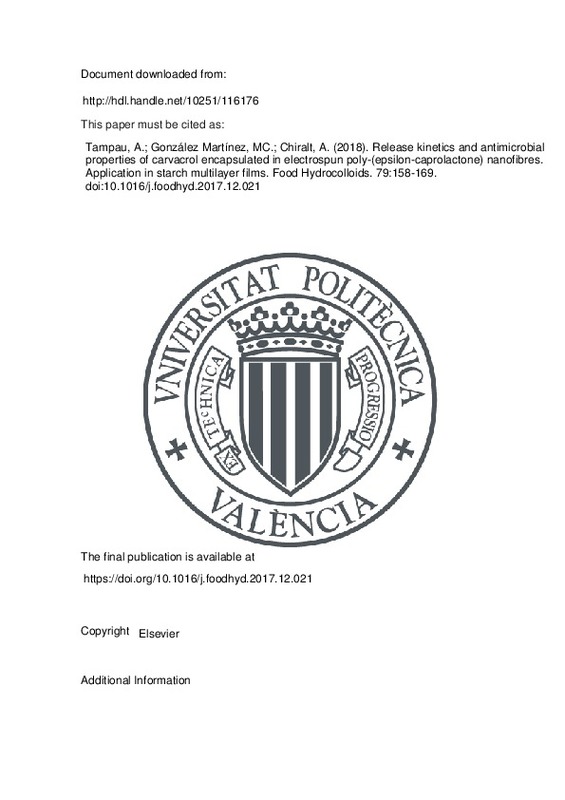JavaScript is disabled for your browser. Some features of this site may not work without it.
Buscar en RiuNet
Listar
Mi cuenta
Estadísticas
Ayuda RiuNet
Admin. UPV
Release kinetics and antimicrobial properties of carvacrol encapsulated in electrospun poly-(epsilon-caprolactone) nanofibres. Application in starch multilayer films
Mostrar el registro sencillo del ítem
Ficheros en el ítem
| dc.contributor.author | Tampau, Alina
|
es_ES |
| dc.contributor.author | González Martínez, María Consuelo
|
es_ES |
| dc.contributor.author | Chiralt, A.
|
es_ES |
| dc.date.accessioned | 2019-01-27T21:01:21Z | |
| dc.date.available | 2019-01-27T21:01:21Z | |
| dc.date.issued | 2018 | es_ES |
| dc.identifier.issn | 0268-005X | es_ES |
| dc.identifier.uri | http://hdl.handle.net/10251/116176 | |
| dc.description.abstract | [EN] Electrospun poly-(epsilon-caprolactone) (PCL) fibre mats encapsulating Carvacrol (CA) were obtained with good encapsulation efficiency (85%) and CA load (11% in the fibre). These mats were effective at controlling the growth of Escherichia coli, when the surface density of CA loaded fibres was 1.2 or 1.8 mg/cm2, in line with the CA released into the culture medium that exceeded the MIC of the bacteria. However, they were not effective at controlling the growth of Listeria innocua, since a greater release of CA was necessary to achieve the MIC of this bacterium. It was not only the CA load in the fibres, but also its release capacity in the media that determined the antimicrobial effect. The fibre showed higher release rate and ratio in less polar simulants, D1 (50% ethanol) and D2 (isooctane) (representing fatty foodstuff), where practically the total amount of CA was released; whereas in more polar systems (simulants A (10% ethanol) and B (3% acetic acid)) a more limited CA delivery (60-75%) occurred, at a slower rate. The antimicrobial action of the active PCL mats was reproduced in multilayer starch films containing the CA-loaded electrospun PCL fibres between two starch sheets, with a slightly delayed response. In the multilayer films, a great reduction in the water vapour permeability was also observed with respect to that of starch films, without relevant changes in other functional properties of the films for packaging purposes. | es_ES |
| dc.description.sponsorship | The authors thank the Ministerio de Economia y Competitividad (MINECO) of Spain, for the financial support for this study as a part of projects AGL2013-42989-R and AGL2016-76699-R. The author A. Tampau thanks MINECO for the pre-doctoral research grant # BES-2014-068100. | |
| dc.language | Inglés | es_ES |
| dc.publisher | Elsevier | es_ES |
| dc.relation.ispartof | Food Hydrocolloids | es_ES |
| dc.rights | Reconocimiento - No comercial - Sin obra derivada (by-nc-nd) | es_ES |
| dc.subject | PCL | es_ES |
| dc.subject | Carvacrol | es_ES |
| dc.subject | Release kinetics | es_ES |
| dc.subject | Antimicrobial action | es_ES |
| dc.subject | Starch multilayer films | es_ES |
| dc.subject.classification | TECNOLOGIA DE ALIMENTOS | es_ES |
| dc.title | Release kinetics and antimicrobial properties of carvacrol encapsulated in electrospun poly-(epsilon-caprolactone) nanofibres. Application in starch multilayer films | es_ES |
| dc.type | Artículo | es_ES |
| dc.identifier.doi | 10.1016/j.foodhyd.2017.12.021 | es_ES |
| dc.relation.projectID | info:eu-repo/grantAgreement/MINECO//BES-2014-068100/ES/BES-2014-068100/ | es_ES |
| dc.relation.projectID | info:eu-repo/grantAgreement/MINECO//AGL2013-42989-R/ES/NUEVOS MATERIALES BIODEGRADABLES MULTICAPA PARA ENVASADO ACTIVO DE ALIMENTOS SENSIBLES AL DETERIORO MICROBIANO Y%2FO OXIDATIVO/ | es_ES |
| dc.relation.projectID | info:eu-repo/grantAgreement/MINECO//AGL2016-76699-R/ES/Materiales Biodegradables Multicapa de Alta Barrera para el Envasado Activo de Alimentos/ | es_ES |
| dc.rights.accessRights | Abierto | es_ES |
| dc.date.embargoEndDate | 2019-06-01 | es_ES |
| dc.contributor.affiliation | Universitat Politècnica de València. Departamento de Tecnología de Alimentos - Departament de Tecnologia d'Aliments | es_ES |
| dc.contributor.affiliation | Universitat Politècnica de València. Instituto Universitario de Ingeniería de Alimentos para el Desarrollo - Institut Universitari d'Enginyeria d'Aliments per al Desenvolupament | es_ES |
| dc.description.bibliographicCitation | Tampau, A.; González Martínez, MC.; Chiralt, A. (2018). Release kinetics and antimicrobial properties of carvacrol encapsulated in electrospun poly-(epsilon-caprolactone) nanofibres. Application in starch multilayer films. Food Hydrocolloids. 79:158-169. https://doi.org/10.1016/j.foodhyd.2017.12.021 | es_ES |
| dc.description.accrualMethod | S | es_ES |
| dc.relation.publisherversion | https://doi.org/10.1016/j.foodhyd.2017.12.021 | es_ES |
| dc.description.upvformatpinicio | 158 | es_ES |
| dc.description.upvformatpfin | 169 | es_ES |
| dc.type.version | info:eu-repo/semantics/publishedVersion | es_ES |
| dc.description.volume | 79 | es_ES |
| dc.relation.pasarela | S\350929 | es_ES |
| dc.contributor.funder | Ministerio de Economía y Competitividad | es_ES |







![[Cerrado]](/themes/UPV/images/candado.png)

